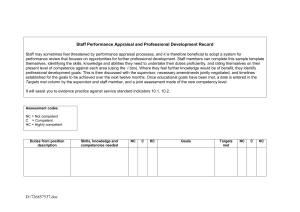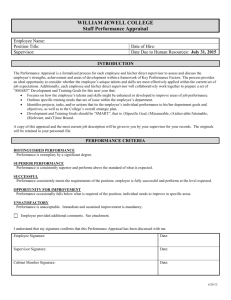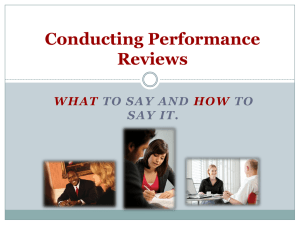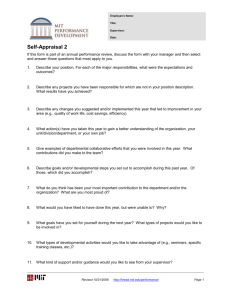Managing Performance at Stanford - Stanford University School of
advertisement
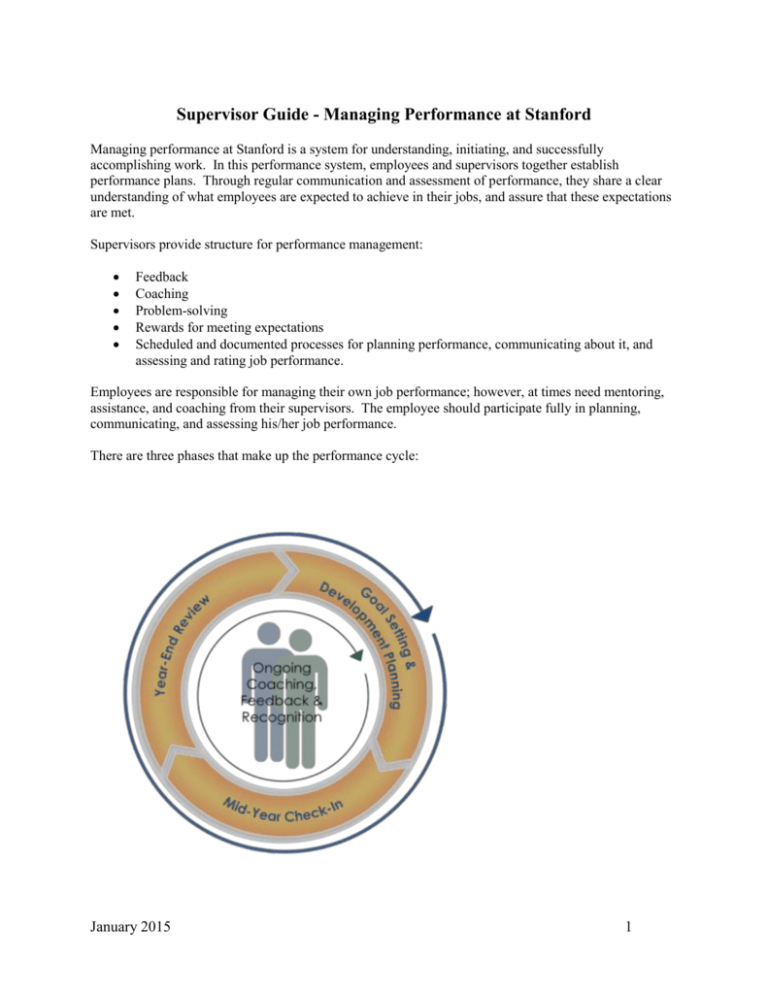
Supervisor Guide - Managing Performance at Stanford Managing performance at Stanford is a system for understanding, initiating, and successfully accomplishing work. In this performance system, employees and supervisors together establish performance plans. Through regular communication and assessment of performance, they share a clear understanding of what employees are expected to achieve in their jobs, and assure that these expectations are met. Supervisors provide structure for performance management: Feedback Coaching Problem-solving Rewards for meeting expectations Scheduled and documented processes for planning performance, communicating about it, and assessing and rating job performance. Employees are responsible for managing their own job performance; however, at times need mentoring, assistance, and coaching from their supervisors. The employee should participate fully in planning, communicating, and assessing his/her job performance. There are three phases that make up the performance cycle: January 2015 1 Phase I: Goal Setting & Development Planning Performance planning is the first and central phase of performance management. It occurs at the beginning of the performance cycle when supervisor and employee decide together what the employee will accomplish during the performance cycle, usually a year. The planning session can be a highly productive conversation, focused on future accomplishments, and clarifying how performance will be assessed. The performance plan that results from this process becomes the foundation for continuing communication throughout the performance cycle, and for assessment and rating at the end of the year. The plan is developed from both the job description and the current needs of the work group. Identifying goals and specific job duties are essential elements of a performance plan. In performance management, three types of goals/expectations work together to form performance expectations for any employee. Job goals with accompanying performance standards Training and development goals Expectations related to policies and practices Performance planning is complete when supervisor and employee have reviewed the goals and expectations established in these categories, and they present a clear picture of what the employee will be doing during the performance cycle. Phase II: Mid-Year Check-In Mid-Year Check-In is the second phase of performance management. Supervisors are encouraged to have on-going communications throughout the year with their employees. Clear communication between supervisor and employee is key to the success of the performance management cycle. During this cycle it is recommended that supervisors organize one scheduled meeting mid way through the cycle to review how the employee is doing with the goals and competencies that were established in phase I. Phase III: Year-End Review In assessment and rating, the third phase of performance management, supervisors meet with employees in a joint process to review the employee’s success in carrying out the performance plan during the entire performance cycle. This is typically known as year-end review or the annual performance appraisal. In completing the annual performance appraisal, here are some steps to consider. The annual performance appraisal should be a mutual effort by the employee and supervisor, with the supervisor guiding and managing the process. Prepare An effective review meeting requires that supervisors have done a good job of managing performance throughout the review period. This includes setting performance expectations and/or goals for the major areas of responsibilities, providing ongoing coaching and feedback, a mid-year check-in, and having January 2015 2 periodic formal meetings to review work progress. When performance management is done well, the performance assessment and evaluation should contain no surprises for the employee. It also eliminates most of the difficulty and fear commonly associated with giving performance reviews. 1. Schedule the meeting with the employee, leaving ample time for the discussion. 2. Schedule a private conference room away from phones and other distractions. Arrange for a meeting place that is neither your office nor the employee’s work area. A conference room is preferable to indicate that you view the process seriously enough to avoid being interrupted or distracted. Schedule adequate time for the meeting. 3. Ask the employee to prepare for the meeting by thinking about how he/she would assess his/her own performance during the review period. Provide the employee with the self-appraisal form and set a date for the employee to return it. In what areas of the job has the employee done especially well? If there are goals or objectives, to what degree have they been met? What help from you, his/her supervisor, does he/she need to be successful? What changes could improve his/her work performance or help him/her to be more satisfied with the job? 4. Review employee’s performance information and documentation for the review period and make notes. Review previously set goals and objectives. Structure open questions to gain feedback from the employee as to how well he/she is meeting the goals or objectives. Review the employee’s job description to determine key areas of responsibility to discuss. All job descriptions should be updated, as needed, before proceeding. Review any feedback you have received that can be referred to (email or letters of commendation, etc.), and the employee’s self-appraisal. Complete a draft document performance appraisal form, using the recommended performance appraisal form (available at http://hrg.stanford.edu). 5. Consult with Human Resource Group, Employee Relations for assistance as needed. Employee Relations Specialists are available to help supervisors (and employees) to complete the process, answer questions regarding the process, and assist in the approach needed to handle performance evaluation. What you assess in a performance appraisal will revolve around: Predetermined criteria from your work group or unit that applies to the entire group or unit Previously set work objectives for an individual employee Performance expectations and work standards that you have previously clarified with the employee Major areas of responsibility for an individual employee (based on the position’s purpose, duties, scope, etc.) Workplace behavior Environmental influences on performance (e.g. budget, organization, strategy) January 2015 3 Conduct the Meeting Setting the atmosphere for the meeting is important. You want to convey that the meeting is for the benefit of the employee, it is important, and that the employee has your full attention. The climate should be cooperative as well as task oriented. 1. Open the meeting. Be friendly and welcoming Explain the purpose of the meeting and the benefit of the discussion Outline the meeting format and any other ground rules 2. Discuss performance categories with the employee, and ask the employee to discuss/summarize the content of his/her self-appraisal form. Focus on one objective or area of responsibility at a time Listen carefully and take notes Ask employee to discuss achievements in each area first and then on any performance that fell short of expectations Summarize employee’s assessment of each section of the self-appraisal to assure understanding Discuss your own assessment after the employee has completed his/her summary For some aspects of performance, the employee will have details that you may be unaware of. Although there should be no major surprises during performance reviews, it’s not realistic to expect that supervisors are familiar with everything that impacts performance. In some cases, the circumstances related to goals not being met may impact the ultimate performance evaluation, so it’s important to listen carefully and probe for more information if necessary. Listening carefully to the employee’s view before adding your own will foster trust in the process. 3. Explain your view of the employee’s performance; give the employee a copy of the draft performance appraisal form. Tell the employee where you agree with his/her assessment; provide recognition of achievements Explain the ratings, and how you arrived at the given rating Explain where you have a different view, being specific and providing information and examples Ask the employee for his/her thoughts or reactions after you have completed your assessment This step encourages in-depth discussion by stating your assessment of performance and then asking the employee for his/her reactions. 4. Work out any differences in perceptions Clearly state the disagreement, discuss both positions, and reach resolution. If there is more than one area of disagreement, discuss and work on one at a time. Acknowledge any emotions that may be present. When differences of opinion surface during performance review, it can be very uncomfortable for both supervisor and employee. It’s important to maintain focus on facts and behaviors and not let the discussion stray into personality issues. As the supervisor, you will need to remain non- January 2015 4 defensive and state your feedback in ways that do not cause the employee to become defensive. State the facts, then ask the employee to comment. If there is disagreement about the facts, you may need to gather more information and finalize your assessment on that particular point later. 5. Summarize discussion and evaluation. Summarize the assessment based on the discussion and employee input Ask the employee if he/she wants to add anything to the assessment State what will happen next (you will write the assessment based on the discussion and the employee will have opportunity to review it and add comments) Ask employee to comment on the process and suggest improvements Ideally, both supervisor and employee leave the discussion feeling good about the opportunity to get together and discuss performance, the employee understands how his/her effectiveness is viewed, and feels interest and support from the supervisor. Follow-Up 1. Write the final version of the performance appraisal including input from the employee. Write only what was discussed in the meeting; there should be no surprises at this point. If you discover an aspect of the employee’s performance that should have been discussed, schedule a second meeting before proceeding. Refer to the notes you took during the meeting for actual words or phrases to include in the written appraisal. Include the employee’s point of view, the workplace factors that affected performance, and disagreements, and steps to address those disagreements, and any other relevant information. Think behaviorally. Write your observations of what the employee has done or said. Use action words (verbs) to describe the actions taken by the employee. 2. Ask the employee to review the written appraisal (and sign); the employee’s signature does not mean agreement. (If employee does not wish to sign appraisal: Write “Employee declines to sign” on the signature line. Make sure you sign the evaluation and date it.) Inform employee that he/she has the option to attach written comments. Evaluate the meeting. What went well? What could be improved about the meeting itself or your role in it? What will you plan to do differently next time? 3. Submit the completed, signed appraisal by the deadline for inclusion in the Personnel file. Ongoing Performance Management and Communication Request employees to turn in a summary of their progress on objectives, projects, or to what degree they are fulfilling performance criteria/standards on a regular basis. Schedule regular meetings with individual employees to discuss and review progress on a regular basis (e.g., once a quarter). Schedule a mid-year check-in with individual employees mid way through the performance cycle. Implement any course of action agreed by you and the employee to improve performance and/or develop new skills. January 2015 5 As appropriate, periodically speak with department clients or customers to get feedback from them as to how well your work group/specific employees are meeting their needs. Schedule monthly or quarterly all-staff meetings (if appropriate to your work group) to discuss and review performance as a group. Manager Communication Guidelines Guideline: Means: Make it a Two-Way Conversation Encourage the employee to participate in the Mid-Year Check-in conversation. Ask questions that will draw the employee into the dialogue. Celebrate Success Provide positive reinforcement for positive performance. Be Honest about Improvement Areas Don’t avoid the subject of improvement needs. Be direct. Encourage and Support Development Focus on continuous learning, growing, and stretching for all employees. Manage Disagreements with Respect Model appropriate conduct. Ask questions and listen well. Supervisor’s Guide – Effective Job Goals Job goals and specific job duties are the center of the performance management system. They define anticipated accomplishments for the employee. The job duties are listed in the position summary (job description), and the supervisor and employee establish goals at the beginning of the performance review period. January 2015 6 Job goals differ from the job description because they identify strategically important projected accomplishments, results, or outcomes for one time period. They also differ from training and development goals, because they identify work accomplishments, not ways an employee will gain new or improved knowledge or skills. They further differ from remedial goals, which state how an employee will overcome gaps that get in the way of accomplishments, and career-related goals, which state how an employee will prepare for different work. The following examples indicate how these kinds of goals may differ. A job goal: Monitor department budgets monthly and communicate status to appropriate faculty member, noting areas for attention and identifying solutions to frequently encountered problems. A related training and development goal: Successfully complete advanced budget training to identify problems and suggest solutions. A related remedial goal (recorded as a training and development goal): Successfully complete advanced budget training to monitor department budgets in a timely manner without having to wait for answers to basic questions. A career-related goal (recorded as a training and development goal): Increase knowledge base in financial areas by completing courses in fund and general accounting. SMART GOALS SPECIFIC (and strategic) Is the goal focused on one issue? Is the goal clearly defined? Is there a clear understanding of what is expected? MEASURABLE Can you measure the quantity? Can you measure the quality? Is there a deadline? ACHIEVABLE Does the employee have authority or control to reach the goal? Does the employee have sufficient influence to reach the goal? Are there resources to enable the employee to reach the goal? RELEVANT AND REALISTIC January 2015 7 Does the goal support the manager’s and overall departmental goals? Is the goal aligned with strategic objectives? TIME FRAME Is there a specific date to complete the goal? Are there milestone dates for review of progress? Testing Your Job Goals Your job goals should add up to an accurate statement of the work for the performance cycle. To be sure that they do, review them. Are there too many or too few? For most jobs, there will probably be three to five job goals, tasks, or responsibilities in a performance cycle. If there are more, consolidate related goals to produce fewer, more comprehensive statements. Do they encompass too much or too little? Each job goal should encompass at least 10% of your whole job, although most goals will probably represent more, and one or two goals may represent most of the job. Are they focused appropriately? They should focus on a strategically important accomplishment, result, or outcome, not on how the job is done. Are they clear? They should describe clear, specific, attainable accomplishments. Check for these characteristics by asking if the statement begins with an action, follows with what is acted upon, and includes other information that you need in order to complete the work successfully. Are they measurable? They should include measurable targets that help answer the questions: “How will I know when I have accomplished the goals?” and “What impact will these results have?” Measurable targets indicate achievement or progress toward achievement of a goal and may include such information as numerical or percentage change, costs of resources, or deadlines. When a goal cannot be measured using quantifiable targets, indicators can be identified to answer the questions: “How can someone tell when a good job has been done in this area?” Are they individual? January 2015 8 Goals are not the same for everybody, but are developed for each employee, with consideration of employee strengths and experience as well as work group needs. Training and Development Goals Stanford 3E Model of Development People learn from all types of experience Stanford’s 3E Model of Development is based upon research that indicates that people learn in their work environments in different ways. Once an individual recognizes what learning he/she would benefit from, and has the motivation to work on it: Development throughout your career will come about 70% from on the job experiences, 20% from feedback, and 10% from courses and reading. “Developmental opportunities work best when orchestrated together. Alone, they are single instruments." 3 levels of opportunities The 3E model provides these opportunities at three levels: On the job learning -- Experience Exposure through targeted inputs and coaching/feedback – Exposure Formal training or reading - Education Experience: Learning acquired by demonstrating the knowledge, skills, attitudes and behaviors in on-the-job situations with real performance consequences. The output of the activity is measurable. Learning by doing. Education: Any formal learning focused on acquiring content or process knowledge, where learning objectives have been established and published. This knowledge is acquired in activities or exercises led by an instructor in a classroom or on the web, or self-paced via the web or other means. Learning via classes. Exposure: Any activities that provide fresh personal insights and 360 visibility to current job and future development opportunities through learning from others, experiencing multiple points of view, interactions with peers, management, and subject matter experts, observations, or personal investigation. Learning from others. January 2015 9 Training and development goals often identify classes or workshops related to job performance. Many other approaches are equally effective. These include but are not limited to: Coaching from a supervisor or manager (Exposure) Coaching from mentors in a formal arrangement (Exposure) Informal coaching from colleagues and others (Exposure) Directed reading with opportunity for discussion (Education) Managing or working with a specific project (Experience) Planning and implementing a new program, service, or system (Experience) Managing a negotiation process (Experience) Studying a problem or performing a needs assessment (Education) Coordinating or managing an event or presentation (Experience) State your training and development goals as carefully as you state your job goals, with clarity, specificity, attainability, and measurement information. Additional resources are located at https://cardinalatwork.stanford.edu. Examples: Incomplete Goal Update website (Job Goal) Serve as HIPAA Lead (Job Goal) Develop computer skills (Development Goal) Complete Cardinal Curriculum (Development Goal) January 2015 Sample SMART Goal Update fellowship program information and faculty biographies on department website by April 2015 in order to present accurate information for the new recruitment season. Serve as HIPPA Lead for the department, communicate compliance and training needs to management, track compliance, and implement new procedures by May 1, 2015 to comply with HIPPA regulations by the required implementation date. Complete SU course on iProcurement by April 2015, practice for one month to become proficient, and assume responsibility for handling purchasing of office supplies for the department by June 2015. Complete Cardinal Curriculum research administration course by August 2015 to increase knowledge of research grant administration, and complete orientation manual for new employees by October 31, 2015. 10



